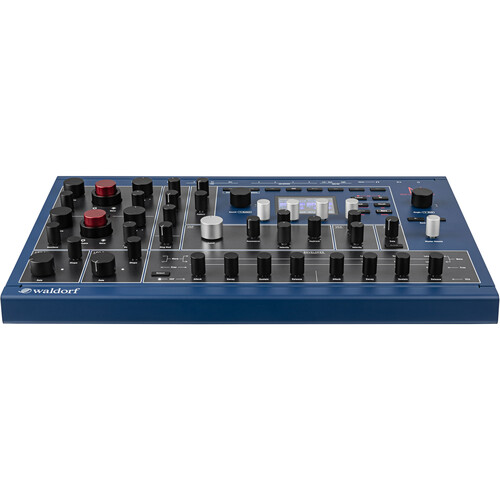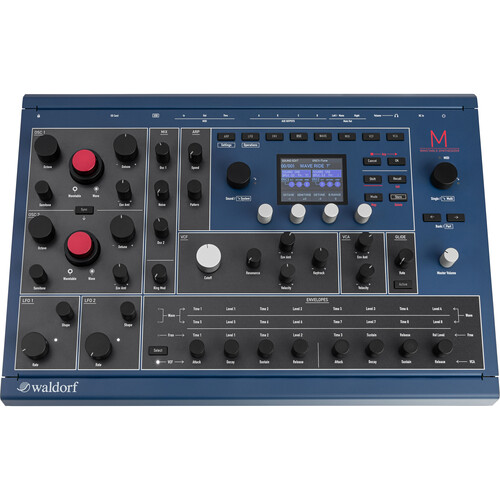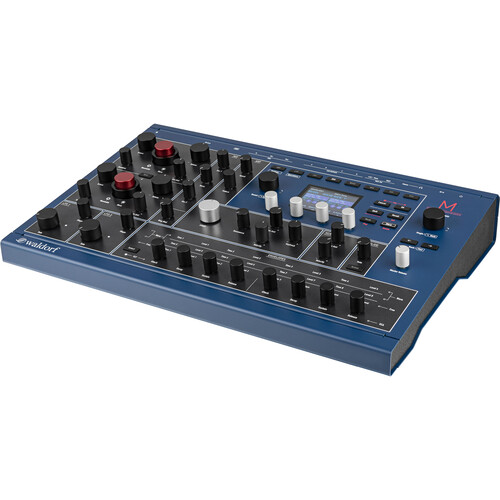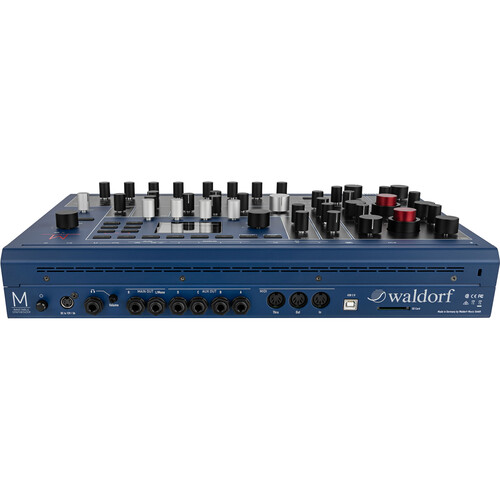Sound designers and synthesizer aficionados will rejoice over the Waldorf M, a four-part, eight-voice hybrid wavetable synthesizer that hails back to the original Microwave synthesizer-complete with analog filters.
The dual oscillator synthesizer features classic Microwave and modern Microwave II/XT sound generation modes with a total of 2048 patches, broken up into 16 banks of 128 sounds. Each sound set was produced by renown sound designers and includes the classic Microwave sound sets, such as MW1 Factory Sound Set, MW1 Soundpool 1-5, the fat-sounding Analogue and Bassco, as well as PPG Wave 2.3 sounds cleverly converted for the original Microwave. The M features an analog lowpass 24 dB/Oct voltage-controlled filter (VCF is the SSI 2144 improved ladder type) with resonance and analog saturation, as well as a true stereo analogue VCA with panning options. Modulation is available from four advanced envelope generators and two LFOs.
The rear panel features a 1/4 stereo headphone output, two 1/4 stereo main outputs, plus four 1/4 aux outputs. The full-sized 5-pin DIN MIDI connectors provide in, out, and thru. Additionally, the instrument features USB MIDI from the Type-B connector that works directly with your computer. An SD-card slot is available for system upgrades and backups of all your favorite patches.
At a Glance
- Oscillators: 2 wavetable oscillators with independent wavetables and two different tone generation models-classic Waldorf Microwave I model and modern Waldorf Microwave II model. There are 96 Factory Wavetables + 32 slots for User Wavetables
- Filter: Analog low-pass 24 dB/oct VCF (SSI 2144 improved ladder type) with saturation
- Amplifier: Analog stereo VCA for each voice
- Envelopes: 4 envelope generators 8 point loopable time/level wave envelope generator, VCF and VCA ADSR envelopes and a free assignable loopable 4 points time/level envelope
- LFOs: 2 LFOs with different waveforms
- Arpeggiator with 16 preset patterns, chord mode and the ability to synchronize to MIDI clock
- Sound storage: 2048 Sound programs + 128 Multi programs
- Polyphony: 8/16 voices polyphony (16 voices available with the expansion board installed)
- Multitimbrality: 4 parts, which can be assigned to 4 individual stereo outputs
- MIDI: USB 2.0 and DIN (5-pin DIN connector with in/out/thru)
- Compatible with classic Waldorf Microwave I sysex messages (sound bank transfer / sound transfer)
- SD card for loading / storing user content as soundbanks and wavetables
Wavetable Oscillator Section
M offers two oscillators with independent wavetable generators. A wavetable is a table consisting of single waveforms. Each waveform is classified by its own special sound character.
The main difference of wavetable synthesis in comparison with other sound-generation principles is the ability to not only to play one waveform per oscillator but also to step through the wavetable via different modulations, thereby creating wavetable sweeps. The results can be dramatic-much more so than most sample playback-based systems can produce.
This principle offers powerful capabilities. To give some examples:
- The wave envelope can modulate the position within the wavetable.
- Each note on a keyboard can access a different wave of a wavetable.
- An LFO can modulate the position within the wavetable. You can create subtle to drastic sound changes.
- User-selected controllers, such as the Mod wheel, can change the position within the wavetable. When you turn the wheel while playing a chord, each note s wave will be modified instantly.
Oscillator Mixer (Mix) Section
In the Oscillator Mixer section, you control the volumes of both oscillators and the Noise generator. If an oscillator volume dial is turned fully counterclockwise, no signal is passed. The Ring Modulator is available, if the Modern Microwave II mode is active.
VCF Section
M offers an analog low-pass filter with 24 dB/oct and resonance. This is a SSI 2144 ladder type with saturation.
VCA Section
M offers an a true stereo analog VCA with panning option. Right beside the VCA section, a glide function can be found.
Envelopes Section
M s envelopes allow you to manipulate sound parameters via rate or timed modulations. M offers four independent programmable envelopes for every sound program:
- VCF Envelope: This envelope is designed to control the VCF but can also be used for other modulations.
- VCA Envelope: This envelope is designed to control the sound volume but can also be used for other modulations.
- Wave Envelope: This envelope with 8 different times and levels (multisegment envelope) is designed to control the wave scanning for a wavetable, but can also be used for other modulations.
- Free Envelope: This envelope with 4 different times and levels (multisegment envelope) can be used freely to perform additional modulations on any module.
An envelope is started by pressing a key. It ascends to its maximum value at the rate determined by the Attack parameter. It then descends at the rate determined by the Decay value until it reaches the predetermined Sustain value. It remains at this value until the key is released. The envelope then descends to zero at the rate determined by the Release parameter.
LFO Section
In addition to the main oscillators, M is equipped with two low-frequency oscillators (LFOs) that can be used for modulation purposes. Each LFO generates a periodic waveform with adjustable frequency and shape.
The Modulation Assignment
A modulation can be described as a signal-generating unit s influence upon a sound parameter. The terms used in this context are Source and Destination. There is no Modulation matrix as in our other Waldorf synthesizers. We made a conscious decision to set up the modulation facilities directly on the corresponding display page, i.e. in the respective sections as Oscillators, VCF or VCA.
The Arpeggiator
An arpeggiator is a device that splits an incoming chord into its individual notes and repeats them rhythmically. Different play modes can be defined for the arpeggiator to cover a wide range of applications.
Waldorf M Classic Specs
| Type | Desktop Module |
| Polyphony | 8 Voices (Expandable to 16 with Optional Board) |
| Multitimbral | Four-Part Multitimbral (Four Parts can be Assigned to Four Individual Stereo Outputs) |
| Oscillators | 2 x Wavetable Oscillators with Independent Wavetables and Two Different Tone Generation Models 96 Factory Wavetables + 32 Slots for User Wavetables |
| Filters | Analog Low-Pass 24 dB/Oct VCF (SSI 2144 Improved Ladder Type) with Saturation |
| VCA | Analog Stereo Voltage-Controlled Amplifier (VCA) for Each Voice |
| Modulation | 4 x Envelope Generators; 8-Point Loopable Time/Level Wave Envelope Generator, VCF and VCA ADSR Envelopes 2 x LFOs with Different Waveforms |
| Arpeggiator | 16 Preset Patterns, Chord Mode, and the Ability to Synchronize to MIDI Clock |
| Storage | 2048 Sound Programs + 128 Multi Programs |
| Compatibility | Compatible with Classic Waldorf Microwave I Sysex Messages (Sound Bank Transfer / Sound Transfer) |
| SD Card | Card Slot for Loading/Storing User Content as Sound Banks and Wavetables |
| Display | LCD Display |
| Audio Outputs | 2 x 1/4" / 6.35 mm TS Main Output (L/Mono + R) 4 x 1/4" / 6.35 mm TS Aux Outputs (A, B, C, D) 1 x 1/4" / 6.35 mm TRS Headphone Output |
| MIDI | 3 x Standard 5-Pin DIN (In, Out, Thru) |
| USB | USB 2.0 MIDI Port: Type-B (MIDI Input/Output Only) |
| Sampling | Recording of Samples from Audio Inputs or Self-Recording of Audio Outputs |
| USB | Computer: USB Type-B Controller: USB Type-A |
| MIDI | Connectors: Input: 5-Pin DIN Out: 5-Pin DIN Thru: 5-Pin DIN |
| SD Card Slot | Export and Import of Presets, Samples, Wavetable, and Software Updates Import of Native Presets |
| Security | Kensington Compatible Receptacle |
| Power | External Power Supply: 12 VDC, 3 A (Included) |
| Current Consumption | 1.8 A Maximum |
| Dimensions | 17.3 x 12 x 3.3" / 44. x 30.5 x 8.5 cm |
| Weight | 12.6 lb / 5.7 kg |
Packaging Info
| Package Weight | 14.31 lb |
| Box Dimensions (LxWxH) | 23.1 x 16.8 x 8.5" |
In the Box
- Waldorf M Classic Hybrid Wavetable Synthesizer with Analog Filters
- Power Supply
- 2-Year Manufacturer Warranty
No posts found































